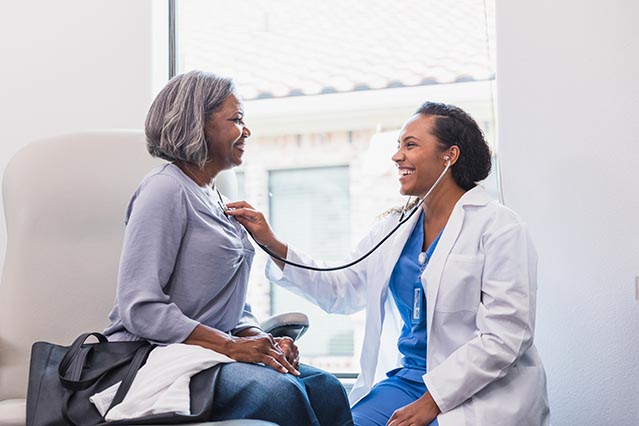What is Abdominal Aortic Aneurysm Screening?

Abdominal aortic aneurysm screening checks to see if an aorta is bulging or swelling. If there is bulging or swelling, then you will be diagnosed with an abdominal aortic aneurysm.
Screening can help spot the aneurysm and prevent it from getting bigger to where it may eventually burst. Screening consists of an ultrasound scan of your abdomen.
Depending on the size of the aneurysm, there are several options for ultrasound screening. For smaller-sized aneurysms, those are performed in the doctor's office. The ultrasound scans will be performed every six to 12 months based on the size of the aneurysm.
No specific medical treatment will prevent an aneurysm from getting bigger. That's why patients must undergo routine ultrasound surveillance once they're diagnosed with an aneurysm. The diagnosis can determine if the aneurysm is enlarging.
The procedure consists of gel being placed on your abdomen. A scanner goes over the abdomen and pictures of the aorta are shown on a monitor.
The test usually lasts about 10 to 15 minutes.
Common Symptoms Abdominal Aortic Aneurysm
Some of the common symptoms associated with an abdominal aortic aneurysm include:
- Pain in the lower back, abdomen or chest
- Tenderness in the abdomen, back or groin area
- Pulsating sensation in the abdomen
- Rapid pulse
- Increased heart rate
- Swelling
- Difficulty breathing
- Fever
- Lightheadedness
- Dizziness
- Nausea
- Weakness
- Pale skin color
If you experience any of these symptoms, it is vital to seek medical attention immediately. However, in some cases, there may be no noticeable symptoms.
Schedule with a Primary Care Provider

If you are worried about symptoms, it is important to seek help immediately. Call your primary care provider. If you do not have one, you can search for one here.
Search Now
What is an Aorta?
The aorta is the main blood vessel that comes out of the heart, runs through the chest and abdomen, and supplies blood flow to the legs.
What are the symptoms of an abdominal aortic aneurysm? Abdominal Aortic Aneurysm symptoms develop slowly and can arise without any signs of symptoms, making them hard to identify.
If an aneurysm becomes big enough, then the experienced symptoms may be: Fainting Fast heartbeat Nausea Sweaty skin Sudden abdominal or back pain Vomiting
What is the Cause of an Abdominal Aortic Aneurysm?
There are several causes for an abdominal aortic aneurysm may occur: Too much plaque buildup in the artery.
Cardiovascular disease Peripheral artery disease Injury that causes an artery wall tear Tobacco use can reduce the strength of an artery wall Blood inflammation.
Who is at Risk for an Abdominal Aortic Aneurysm?
Abdominal Aortic Aneurysm is four times more common in males than in females.
About five percent of males will be diagnosed with an aneurysm during their lifetime. Aneurysms become more common above age 65.
Risk factors for aneurysms include: History or current tobacco use: Smoking and chewing tobacco is the biggest risk for developing aortic aneurysms.
It can damage the aorta walls, increasing the likelihood of developing an aortic aneurysm and rupture.
The more a person smokes and chews tobacco, the likelier the chances of an aortic aneurysm developing.
Chronic alcohol use: Heavy alcohol use is associated with developing an abdominal aortic aneurysm.
High blood pressure: High blood pressure increases the likelihood of developing an abdominal aortic aneurysm.
Family history/genetics: A family history of suffering from abdominal aortic aneurysms increases the risk of developing that condition.
Being male: Men are more at risk of abdominal aortic aneurysms than women. Most patients found to have an aneurysm either have it identified through a screening program or an accidental finding from an unrelated medical check-up.
What are the Complications of an Abdominal Aortic Aneurysm?
A tear of the aorta wall or an aneurysm rupturing are the two most common complications.
Ruptures sometimes cause bleeding internally and can become life-threatening.
The faster and larger an aneurysm grows, it has the likelier chance of rupturing. An aneurysm can also increase the possibility of a blood clot forming.
The signs and symptoms of a ruptured aortic aneurysm include: Sudden and intense pain in the back or abdomen. It's also described as a tearing sensation A fast pulse Having low blood pressure
When Should I get Medical Help for Abdominal Aortic Aneurysm?
Make an appointment as soon as possible if you are experiencing severe complications or symptoms.
An ultrasound scan may be performed on your abdomen to check and see if you have an abdominal aortic aneurysm.
Call 911 immediately if an abdominal aortic aneurysm bursts and you need immediate attention.
What to Expect During an Abdominal Aortic Aneurysm Stent Procedure?
If the aneurysm gets large enough to where it needs repair because of the risk of rupture, then the endovascular stent graft will be used.
Stents will be placed within the aneurysm to seal off the aneurysm to keep it from getting larger and prevent it from rupturing.
There are several advantages to the endovascular stent graft compared to open surgery to treat aneurysms. The operative time is less, the complication rate is less, and the recovery time is less. The traditional way to fix aneurysms is with an open surgical operation where the aneurysm is replaced with some new artificial tubing.
This is done for patients that aren't candidates for endovascular stents. The patient spends one night in the hospital, and most patients go home the following day. The patient is recommended not to do any real heavy lifting or strenuous activity for a couple of weeks. The patient will be told to allow the healing process to proceed as properly as possible.
How to Prevent Abdominal Aortic Aneurysm?
Quit smoking and chewing tobacco: It is the leading cause of abdominal aortic aneurysms.
Talk to your doctor if you want to discuss quitting smoking.
Your doctor may recommend medications and therapy.
Consume a healthy diet: Eating fruits, vegetables, whole grains, fish, poultry, and low-fat dairy products can help. In addition, try to avoid saturated and trans fats and limit salt.
Maintaining healthy blood pressure and cholesterol: Prescribed medication can help control blood pressure and cholesterol.
Exercise: Regular exercise consisting of 150 minutes per week can help prevent abdominal aortic aneurysms.
Heart Health
 What to Expect at Your First Cardiologist Visit
What to Expect at Your First Cardiologist Visit
 Who Qualifies For a TAVR Procedure?
Who Qualifies For a TAVR Procedure?

